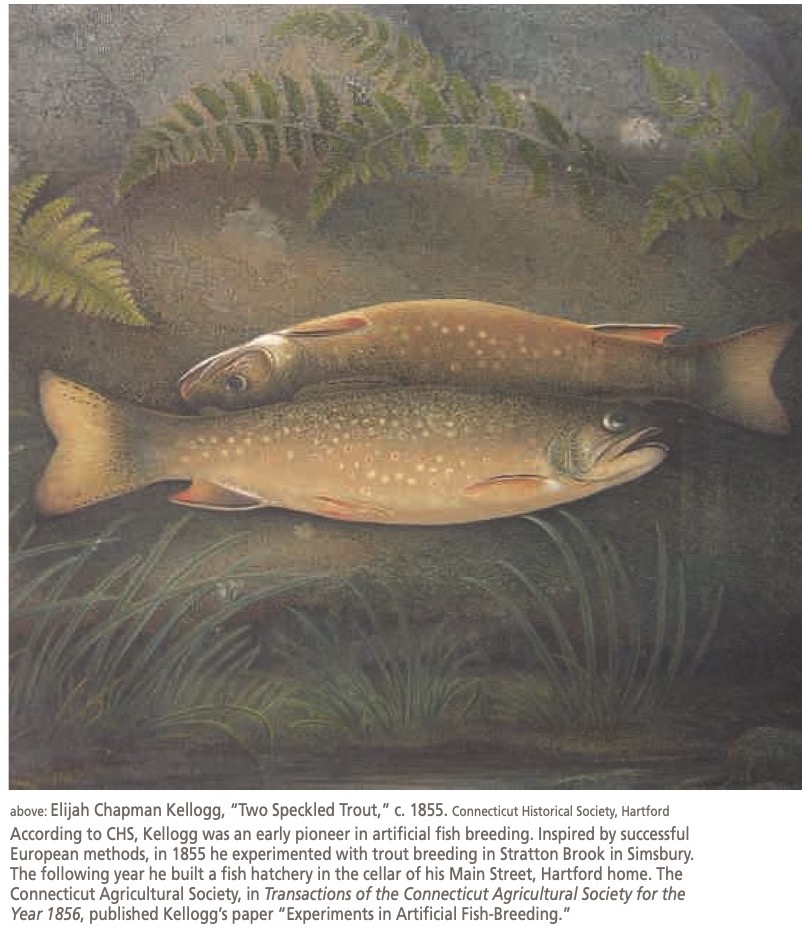(c) Connecticut Explored Inc. Spring 2021
Subscribe/Buy the Issue!
In 2016, to mark the agency’s 150th anniversary, the Connecticut Bureau of Natural Resources (part of the Connecticut Department of Energy and Environmental Protection, or DEEP), published a timeline of major milestones in the conservation of fish, game, and forests in the state. The agency began as the state Fisheries Commission in 1866 and today includes the divisions of wildlife, inland fisheries, marine fisheries, and forestry.
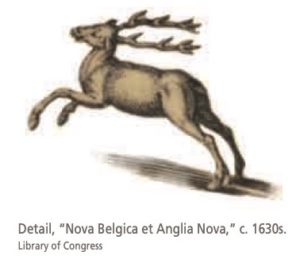 The timeline, from which selected milestones are noted below, illustrates the arc of loss and restoration of fish, game, and forests in the state. The loss of animal species through overhunting was felt within decades of British colonial settlement, and in the 18th century habitat loss due to deforestation was a factor. For a story about how Native Americans were affected in the colonial period, see page 36. Conservation efforts began early, but restoration efforts did not get underway until the 20th century. Find the bureau’s timeline at portal.ct.gov/DEEP/Wildlife/BNR-150th-Anniversary/BNR-Historical-Timeline.
The timeline, from which selected milestones are noted below, illustrates the arc of loss and restoration of fish, game, and forests in the state. The loss of animal species through overhunting was felt within decades of British colonial settlement, and in the 18th century habitat loss due to deforestation was a factor. For a story about how Native Americans were affected in the colonial period, see page 36. Conservation efforts began early, but restoration efforts did not get underway until the 20th century. Find the bureau’s timeline at portal.ct.gov/DEEP/Wildlife/BNR-150th-Anniversary/BNR-Historical-Timeline.
1677: Though abundant today and even considered a nuisance, deer became a rare resource within decades of British settlement due to overhunting, as evidenced by this Connecticut law: “Whereas it is found to be very prejudicial to the public weal to transport out of this Colony the skins of bucks and does, which are so serviceable and useful for clothing, it is now ordered by this Court that … whosoever shall transport any such skins out of this Colony, he shall forfeit the skins so shipped or the full value of them … .”
1698 Connecticut restricted deer hunting to between July 15 and January 15.

Israel Putnam Wolf Den, Mashamoquet Brook State Park, Pomfret, 1902. State Archives, Connecticut State Library. According to the plaque to the right of the cave entrance, “One night in December 1742, Israel Putnam entered this hillside den and shot the she-wolf that had been killing the sheep, lambs, goats, hens, and other domestic animals be- longing to him and his neighbors.”
1742: The last documented wolf in Connecticut was shot in Pomfret by Israel Putnam. This event became legendary and is marked by a plaque adjacent to the cave entrance where the event took place in what is now Mashamoquet Brook State Park.
1798: Atlantic salmon were abundant in the Connecticut River before the first dam across the river was completed at Turners Falls, Massachusetts in 1798. The life cycle of Atlantic salmon, which have to spawn upstream in freshwater, was not then understood. Connecticut’s Fish Commission reported in 1870 that, after the dam was built, “the salmon ascended the river as far as the dam and were taken in great numbers the first year. The following year they were still a plenty, and then they began rapidly to decrease in numbers, and at the end of four years they had nearly all disappeared, and have never been seen since.” A similar fate awaited the state fish, the American shad. [See “Shad: The Official State Fish,” Spring 2006.]
1850: Connecticut was one of the first states to enact a law protecting non-game birds. It protected insectivorous birds and removed doves from the list of game birds.
1866: The Fisheries Commission was created by the state legislature. The commission was charged with assessing the shad and salmon fisheries in Connecticut and was tasked with finding ways to rebuild and sustain these valuable resources.
1869: The Connecticut General Assembly passed a law appointing the first law-enforcement officers, to be appointed by the towns, for the protection of wildlife resources. This function moved to the state beginning with the establishment in 1895 of the Connecticut Board of Fisheries and Game, which included appointment of Special Game Protectors. The legislature also passed an act prohibiting the collection of creeping fern (Lygodium palmatum), also known as Hartford fern, in response to rampant over-collection of this species for decorative purposes. This legislation is often cited as the first plant-protection law in the United States.
1871: The Fisheries Commission requested the state’s first fishway, asserting that fishways were needed on all major rivers and streams and that “refuse matter from mills and factories” needed to be cleaned up. [See “When the Rivers Ran Black,” page 20.] The first inland-fisheries regulation was adopted, making it legal to “take [fish]by hook and line only.”
1875: The Connecticut Agricultural Experiment Station was founded. [See page 26.]
1884: The state introduced rainbow trout into local streams. Early state fisheries workers were fish culturists charged with experimenting to introduce new species. During the mid- to late-1800s, largemouth bass, smallmouth bass, walleye, landlocked salmon, brown trout, lake trout, bluegill, common carp, and calico bass were introduced to many waters. The first state-owned fish hatchery was opened in 1899 in Windsor Locks. Others followed in Burlington (1923), Kensington (1930), and Plainfield (1972).
1886: A bill was passed to establish Arbor Day in Connecticut. The first observation was held in spring 1887.
1893: Connecticut passed a law giving complete protection to white-tailed deer for 10 years; the law was subsequently extended to 1917.
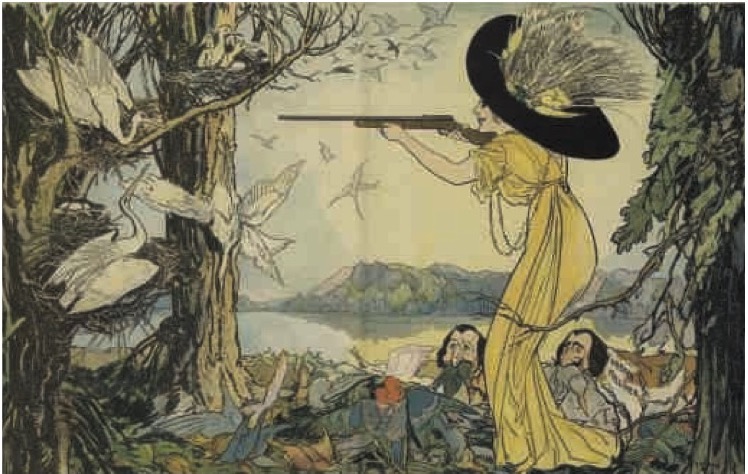
“Woman Behind the Gun,” possibly a reference to Coco Chanel, comments on fashion’s role in the hunting of birds to near extinction. Puck, May 24, 1911. Library of Congress
1901: Connecticut adopted a more expansive law protecting non-game birds and prohibited hunting on Sundays. An effort began in the late 1800s to protect birds whose plumage was used to adorn women’s hats. [See “Site Lines: Birdcraft,” Fall 2017.]
1903: Meshomasic State Forest became the first state forest in Connecticut. Today there are 32 forests in the Connecticut State Forest System, totaling about 170,000 acres.
1905: The Connecticut Forest Fire Law was established and the first fire wardens were appointed.
1907: Owners and lessees were allowed to shoot deer found damaging crops on their land.
1908: Eighty-eight ring-necked pheasants were introduced in Windsor Locks to reduce hunting pressure on native game birds in the state.
1914: Two beavers were reintroduced in Union; others began to move from New York and Massachusetts into northeastern and northwestern Connecticut. In the 1950s the state Board of Fisheries and Game initiated a trap-and-relocate program to move problem beavers to more suitable habitats in the state and opened the first regulated trapping season in 1961. [See “Why We Need Beavers,” Spring 2019.]
1916: The first minimum size for keeping lobsters was adopted (4 ⅛-inch rostrum length).
1933: The state established a women-only fishing reserve on the Branford River and a women’s hunting grounds in Farmington and hired its first female game warden, Edith Stoehr, to patrol both reserves. [See “Connecticut’s First Female Game Warden,” Summer 2006.]
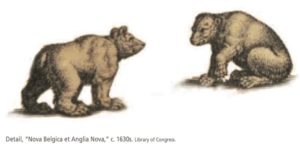 1955: A large black bear was spotted in the Pleasant Valley section of Barkhamsted. The Connecticut Wildlife Conservation Bulletin reported that “Several areas of Connecticut have suitable conditions for this mammal, and perhaps Connecticut can someday again include this interesting animal, once common, on its wildlife list.”
1955: A large black bear was spotted in the Pleasant Valley section of Barkhamsted. The Connecticut Wildlife Conservation Bulletin reported that “Several areas of Connecticut have suitable conditions for this mammal, and perhaps Connecticut can someday again include this interesting animal, once common, on its wildlife list.”
1956: The first officially acknowledged photograph of a moose was taken in Ashford. Though not certain that moose were ever native to Connecticut, the BNR estimates that today, due to pressure on habitat to our north, as many as 100 live in northern Connecticut.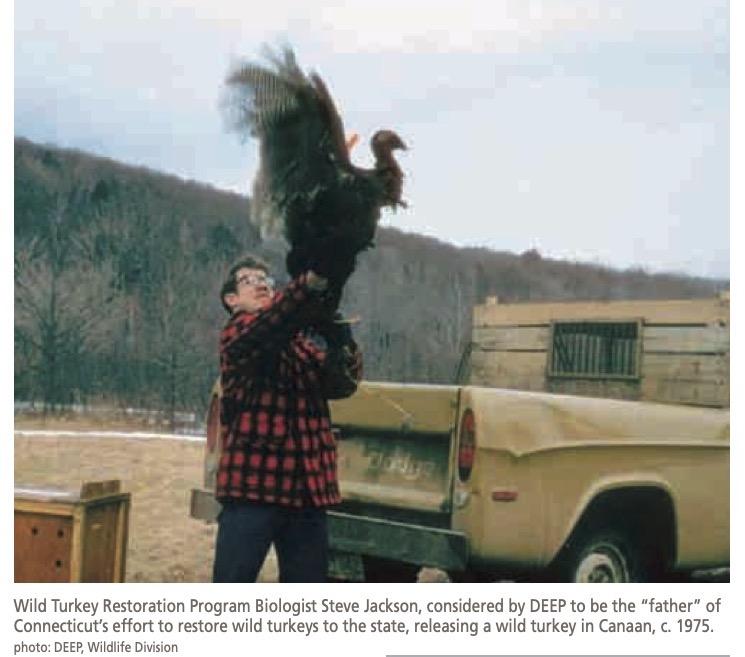
1959: The state legislature reorganized state commissions into the Department of Agriculture and Natural Resources, bringing together all agencies concerned with the new environmental movement in the state.
1963: Coyotes were documented in Connecticut in the 1950s, but one killed behind the Kensington Fish Hatchery in 1963 was one of the earliest recorded in the state. Today, coyotes are common throughout the state.
1965: Use of the pesticide DDT for aerial spraying of wooded areas in Connecticut to control the gypsy moth was banned by the State Board of Pesticide Control. Use of DDT was banned by the federal government in 1972.
1967: The interstate and federal program to restore Atlantic salmon to the Connecticut River began. Atlantic salmon were first spotted in the Connecticut River in 1974, and in 1981 529 were recorded in the river.
1971: The Connecticut Department of Environmental Protection (DEP) was established.
1974: The Deer Management Act was passed by the state legislature, establishing science-based regulations to manage deer populations.
1975: Connecticut’s successful Wild Turkey Restoration Program began with the release of 22 wild-trapped birds from the State of New York.
1989: The fisher was reintroduced into northwest Connecticut.
1992: The first successful bald-eagle nesting in Connecticut since the 1950s wasrecorded.
Additional source: U.S. Department of Agriculture Biological Survey, “Chronology and Index of the More Important Events in American Game Protection, 1776 – 1911,” Bulletin, (Issue 41, 1912).
Explore!
Easily find all of the Connecticut Explored stories noted above on our new TOPICS page at ctexplored.org/landscape-environment.
Connecticut Wildlife Magazine, published by DEEP
Find information about subscribing and reading back issues online at portal.ct.gov/DEEP/Wildlife/Connecticut-Wildlife-Magazine#2016
Hands on the Land: Art & the Environment in the Connecticut River Valley
An exhibition of contemporary art that interprets concepts of change, impact, inspiration, reflection, or other aspect of human impact on the Connecticut River Valley.
On view mid-March to mid-October 2021
Connecticut River Museum, 67 Main Street, Essex
ctrivermuseum.org


